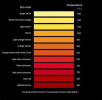tsavickas36
Gold Member
- Joined
- Jan 14, 2025
- Messages
- 20
Another newbie question and I am sure I will feel foolish once I get the answer but thought I would post anyway.
I am taking on projects for people just to learn new things so my buddy asked me to make him a big chopper for the grill.
The tip of the blade to the handle end is around 11”. Top to bottom is around 3 1/2”.
I picked up a great deal on some 2 1/2” x 3/8 thick 52100 so thought it would be great to use it to forge out to 1/4 for the knife.
Saturday night a buddy helped, we heated it in the forge until it was screaming orange and pounded it with an 8lb sledge.
I do live in Michigan and it was only around 20 degrees so not sure if it was cooling too quick or not hot enough.
I am in pretty good shape but we pounded this thing for an hour and barely got it to move.
Not really sure where to even start but any advice would be great to get this worked out to my desired 1/4 stock.
I don’t know how to include pictures but we got it out to a little under 3” for about 6”.
I am taking on projects for people just to learn new things so my buddy asked me to make him a big chopper for the grill.
The tip of the blade to the handle end is around 11”. Top to bottom is around 3 1/2”.
I picked up a great deal on some 2 1/2” x 3/8 thick 52100 so thought it would be great to use it to forge out to 1/4 for the knife.
Saturday night a buddy helped, we heated it in the forge until it was screaming orange and pounded it with an 8lb sledge.
I do live in Michigan and it was only around 20 degrees so not sure if it was cooling too quick or not hot enough.
I am in pretty good shape but we pounded this thing for an hour and barely got it to move.
Not really sure where to even start but any advice would be great to get this worked out to my desired 1/4 stock.
I don’t know how to include pictures but we got it out to a little under 3” for about 6”.



